Small businesses are the lifeblood of the world’s economy. While they can’t compare to big business in sheer raw numbers, nothing drives local economies quite like small businesses. Furthermore, small businesses are the driving force behind many independent innovations and often turn people into aspiring entrepreneurs.
If we were to talk about the significance of small businesses in the world, we’d be here the entire day, so let’s discuss numbers instead. In this article, we’ll take a look at some of the most interesting statistics regarding small businesses of the world that will paint a portrait of just how substantial and important they are on a global scale.
Interesting Small Business Stats
- Out of all of the businesses in the world, about 95% are small businesses.
- There are 30.2 million small businesses in the U.S.
- Small businesses account for 64% of all new jobs in the U.S.
- About 69% of all small businesses in the U.S. start their operations from home.
- The most successful age to start a small business is 45.
- About 54% of all small business owners have at least a bachelor’s degree.
- The top industry for small businesses is food and restaurants.
- The most profitable small businesses worldwide are in accounting, tax preparation, bookkeeping, and payroll service.
- 86% of small business owners make less than $100,000 a year in income.
- 92% of small business owners don’t regret starting their business.
So, without further ado, let’s get into the stats.
How many small businesses are there in the U.S.?
There are many small businesses worldwide, but one of the best places for small businesses is the United States of America. The U.S. has many programs in place to support small businesses. Small businesses are doing wonders for American small towns and local economies.
To get a better picture of the number of small businesses in the U.S., let’s look at some statistics.
1. There are 30.2 million small businesses in the U.S. and over 99% of all businesses are small businesses.
Small businesses are a huge part of the United States economy. According to a recent study, there are 30.2 million different small businesses across the entire U.S. Small businesses comprise 99.9% of all United States businesses.
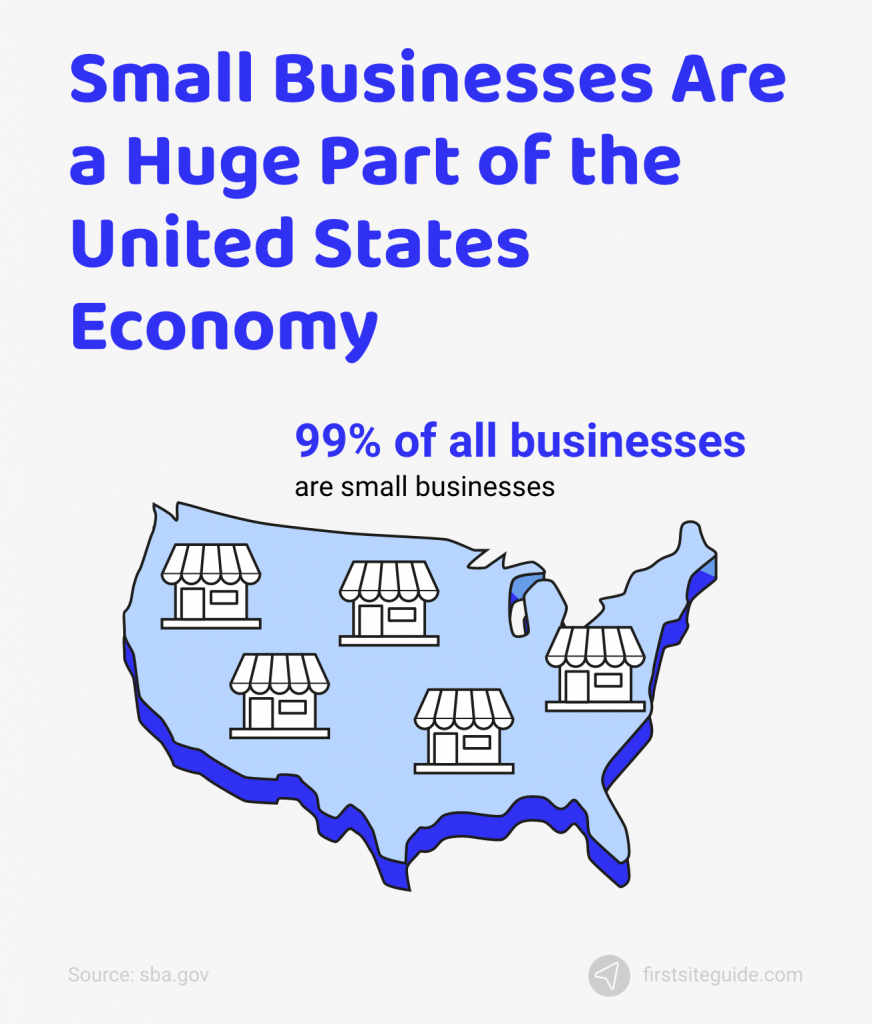
Source: Sba.gov
2. Small businesses account for 64% of all new jobs in the U.S.
Small businesses are a big deal when it comes to global employment rates. They account for about 64% of new jobs in the U.S. alone, and they create about 1.5 million job positions.
Source: Sba.gov
3. Out of all of the businesses in the world, about 95% are small businesses.
Small businesses are vital because they create an astonishing number of jobs. They account for over 95% of all firms worldwide and about 60%-70% of the global employment rates, leading economies worldwide.
Source: Globalnaps.org
4. 24,813,048 small businesses in the United States are non-employer.
Just because a business is small doesn’t mean it has to employ anyone. A lot of people start small businesses to legitimize their careers and practices. The United States government calls these businesses non-employer businesses. Furthermore, there are about 24,813,048 non-employer businesses in the U.S. today.
Source: Smallbiztrends.com
5. 69% of U.S. startups are started at the entrepreneur’s home.
We’ve all heard the touching tale of how most of the world’s big businesses started. Harley Davidson, Amazon, and even A.M.G. all started in garages, and that seems to be a trend across many small businesses. About 69% of all small businesses in the U.S. start their operations from home.
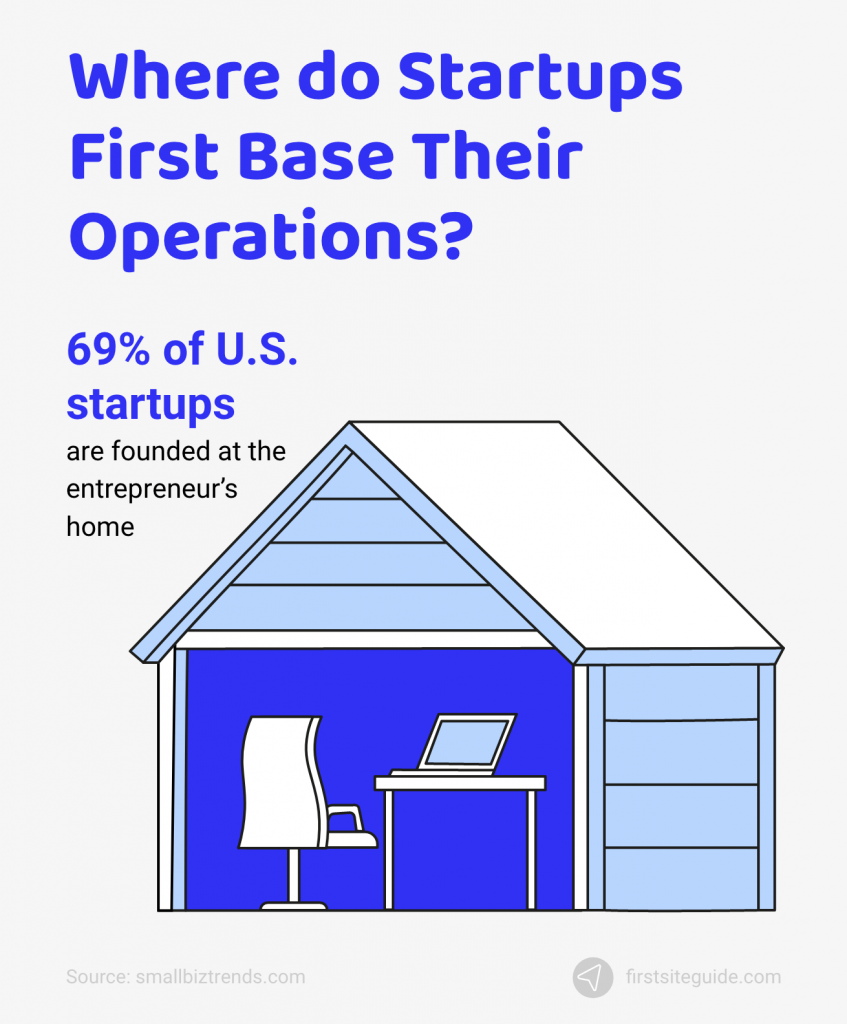
Source: Smallbiztrends.com
6. Small business measuring tactics
Depending on your business type, number of employees, and revenue, whether or not your business can be labeled as small can vary. For industries such as manufacturing and mining, anything under 500 employees is considered small. For wholesale trade, it’s 100 employees.
Other businesses such as retail and service need to have an annual average revenue of less than 6 million dollars. For construction, the number rises to $28.5 million, special trade contractors are $12 million, and agriculture is $750 thousand to be considered a small business.
Source: Sba.gov
7. Small businesses created 1.9 million net jobs in 2015.
Small businesses create a lot of jobs, and as time goes by, that amount is growing. In 2015, small businesses created about 1.9 million net jobs, and firms that employed less than 20 people experienced the most significant growth, adding about 1.1 million net jobs.
Source: Sba.gov
8. The employment share of the self-employed and micro-enterprises is highest in South Asia, Africa, and the Middle East.
A comparison of the different regions indicates that the share of self-employment in total employment is highest in South Asia (67%), followed by sub-Saharan Africa (50%) and the Middle East and North Africa (44%).
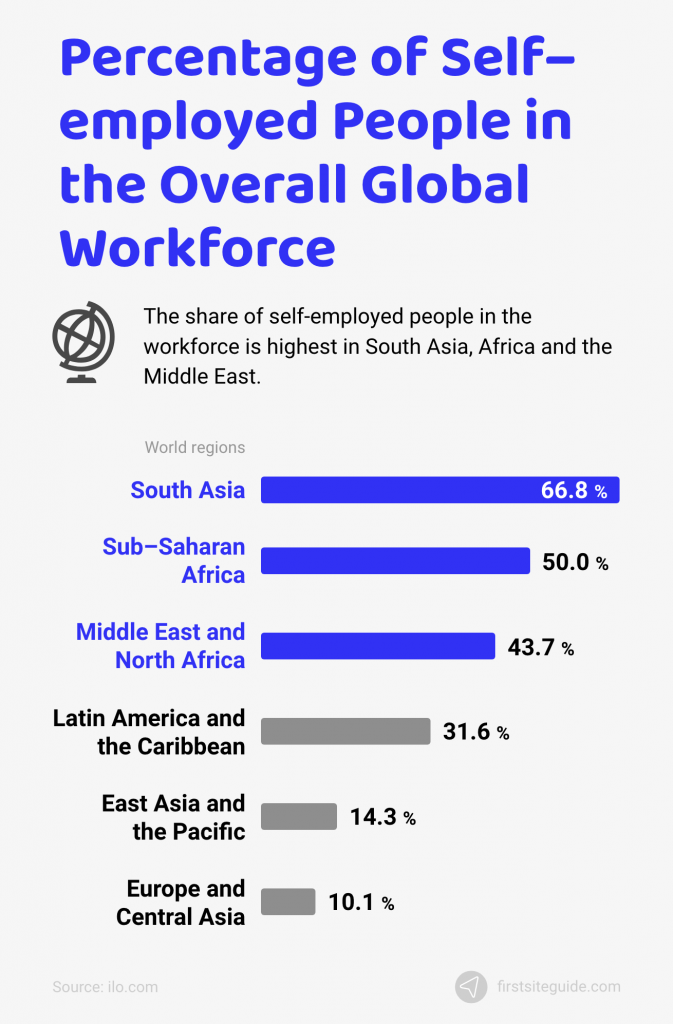
Source: Ilo.com
9. Total early-stage Entrepreneurial Activity (TEA) leaders by region of the world
The biggest Total early-stage Entrepreneurial Activity (TEA) in Asia and the Pacific is from Armenia at 21%. The highest TEA in Europe and North America is Canada with 17%. For Latin America, it’s Ecuador with 37%, and for the Middle East and Africa, it’s Madagascar with 18%.
Source: Gemconsortium.org
10. Most micro-businesses employ nine to ten people.
When you think of micro-businesses, you’ll need to take the small business label and downscale it even further. However, there are many micro-businesses, most of which employ nine to ten people.
Source: Bls.gov
Small business owner’s stats
Small business owners are a diverse bunch. It seems that in this day and age, a lot of people want to get out of the wage-cage and start their own small business, and it’s easy to see why. While a significant portion of small businesses fails, those that persist are usually moderately successful, allowing them to focus on opening more small businesses or taking their business to the next level.
Let’s take a look at some of the interesting statistics related to small business owners.
11. 45 is the most successful age to be a small business owner.
Small business owners are very diverse when it comes to their age, but the most successful age to start a small business is 45. That’s because people in that age demographic aren’t first-time entrepreneurs, and they have a lot of life experience to fall back on.
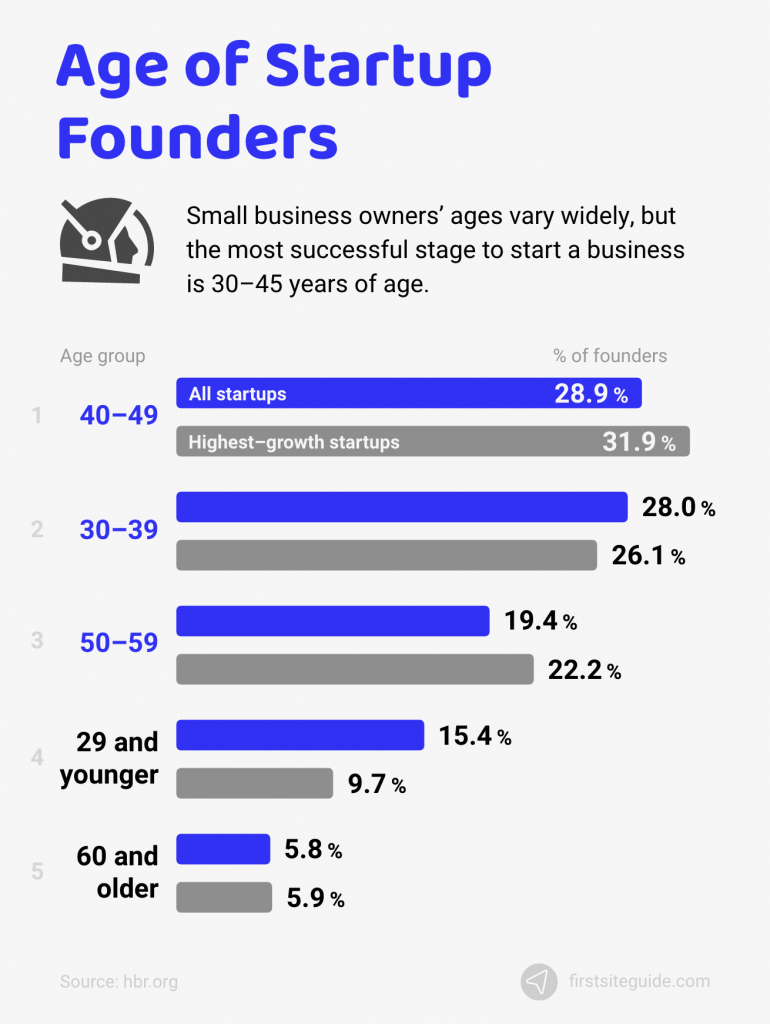
Source: Hbr.org
12. Young entrepreneurs are 188% more likely to side-hustle with a small business.
The craze involving passive income is becoming more prominent every year, which has driven many young entrepreneurs to seek side hustles. Millennials and Gen Z people are about 188% more likely to start a small business as a side hustle than other age demographics.
Source: Salesforce.com
13. There are 8 million minority-owned businesses.
To say that small businesses are becoming diverse would be an understatement. There has been a lot of focus placed on ensuring that minorities have access to support and means to start a small business, resulting in about 8 million minority-owned businesses in the U.S.
Source: Sba.gov
14. About 54% of all small business owners have at least a bachelor’s degree.
Education is one of the most important factors when starting a small business, but you might be surprised to find out that about 53.78% of small business owners have a bachelor’s degree or higher.
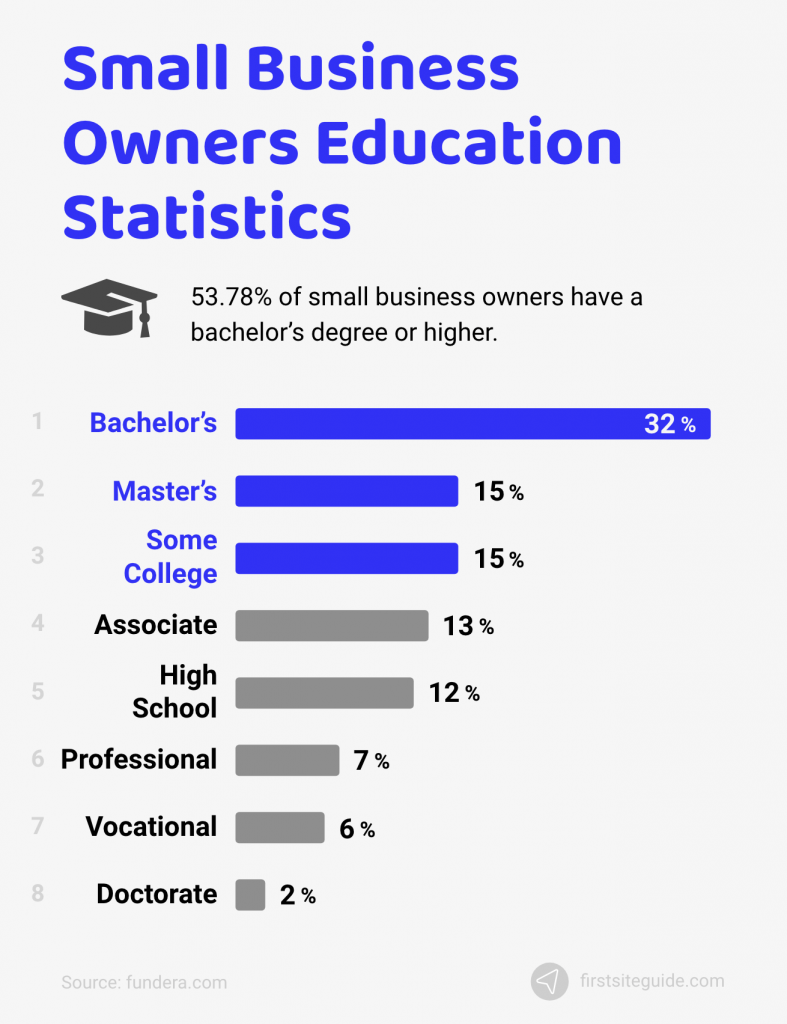
Source: Fundera.com
15. About 4.3% of all small businesses in Canada are focused on innovation.
Small businesses are often trying to fill out a niche and grab a slice of a buzzing market. Some small businesses tend to carve out the market themselves before they have any real competition. The industry leader is Canada, with about 4.3% of small businesses doing something completely new.
Source: Gemconsortium.org
16. 38% of small business owners say self-discipline is key.
One of the essential skills to learn as an entrepreneur is self-discipline. 38% of young entrepreneurs list self-discipline as the most important characteristic for running a successful small-scale business.
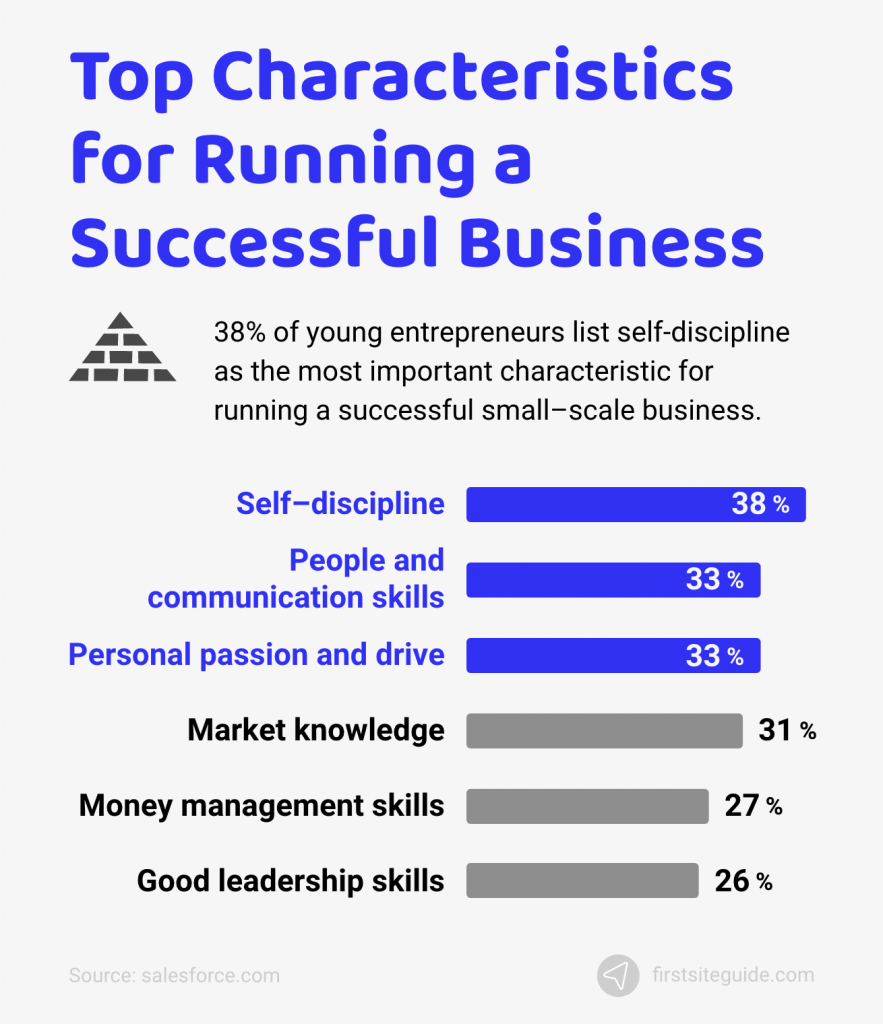
Source: Salesforce.com
17. 29% of small business owners said money-making was the main driver behind starting a small business.
People open small businesses for many different reasons, and the most popular one is to make more money. About 29% of small business owners have listed this as the most important driving factor behind their decision to open a small business.
Source: Guidantfinancial.com
18. 19.4 million non-employer businesses in the U.S. are sole proprietorships.
Remember when we talked about non-employer businesses? Well, about 19.4 million of them in the U.S. are one-man-show sole proprietorships, 1.6 million are partnerships, and the smallest amount of them, 1.4 million, are corporations.
Source: Smallbusiness.yahoo.com
Small business industries
Just like any business, small businesses are split up into their respective industries. Small businesses have completely different industries than big businesses, as some industries are oversaturated and dominated by big businesses. That’s quite positive, as it means that small businesses tend to fill more niche industries that are still quite important.
When it comes to the industries of choice for small businesses, let’s take a look at the numbers.
19. The top industry for small businesses is food and restaurants.
Small business industries tend to vary widely based on location, economy, and the entrepreneurs that start them. However, the five most popular small business industries are:
- Food & restaurants
- Retail & fashion
- B2B (Business to Business)
- Health, beauty, and fitness
- Residential and commercial

Source: Guidantfinancial.com
20. The most profitable small businesses are accounting, tax preparation, bookkeeping, and payroll services, with a profit margin of 19.8%.
The most profitable small businesses worldwide are in accounting, tax preparation, bookkeeping, and payroll services, which net about a 19.8% profit margin on their services. The second most profitable small business niche is legal services with a profit margin of 17.8%, followed by oil and gas extraction with a profit margin of 16.4%.
Source: Forbes.com
21. The biggest employers in the small business world are professional, scientific, and technical services, with 796,737 employees.
The biggest small businesses based on industry and firm size were professional, scientific, and technical services, with the most employees counted at 796,737.
Source: Sba.gov
How much do small businesses earn?
Defining a small business is quite hard. While the first thing that comes to mind might be a mom-and-pop shop on the corner of your street, the small business moniker can also apply to a local chain of restaurants.
To get a better perspective on what substantiates a small business, let’s look at their earning statistics.
22. About 86% of small businesses report less than $100,000 in yearly revenue.
86.3% of small business owners tend to make less than $100,000 a year and the average salary of a small business owner is somewhere around $67,919 a year.
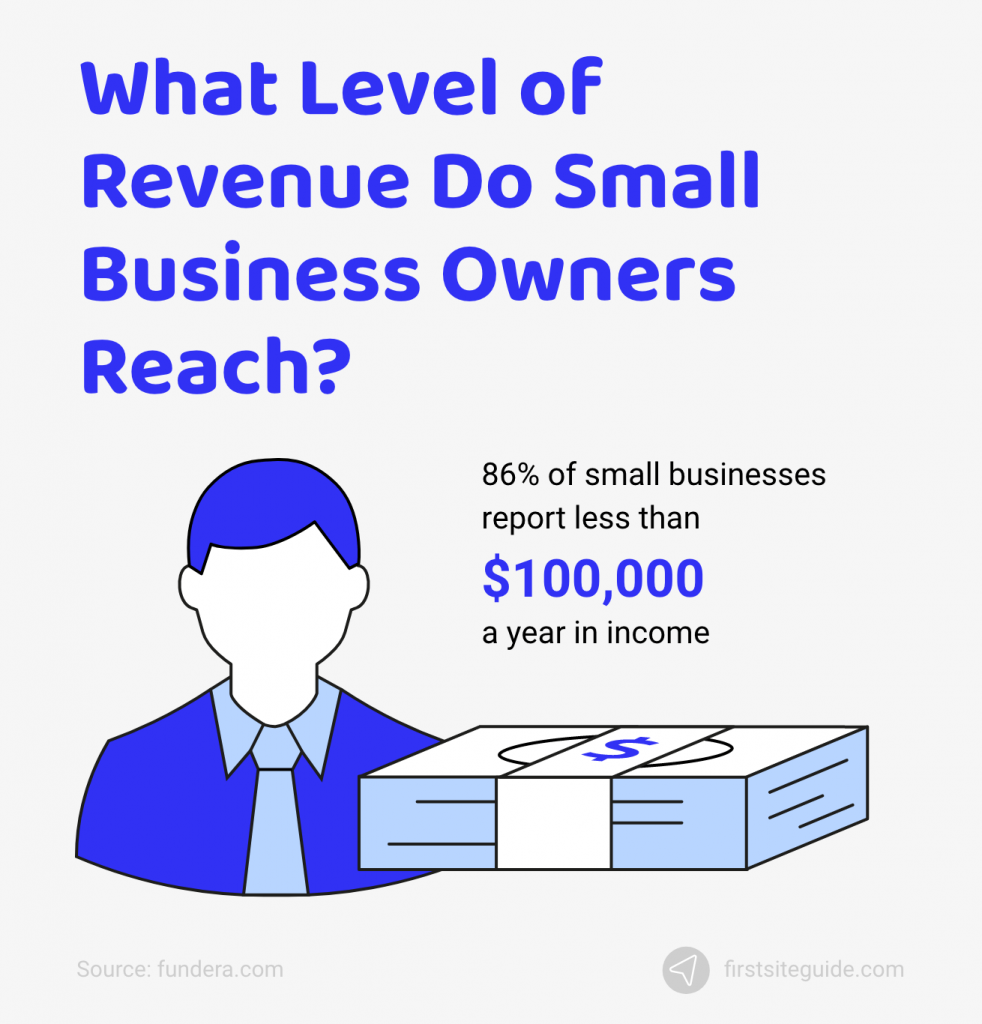
Source: Fundera.com
23. Lawyers make the most money, with an average income of $141,890.
By far, the biggest profits are made by lawyers, with the average income clocking in at $141,890. Software and App developers come in second place, yielding an average annual return of about $106,710. They’re followed by independent artists, writers, and performers who earn $98,960 on average.
Source: Bls.gov
24. Non-employer small businesses in the U.S. averaged an annual revenue of $46,978.
Non-employees have a 30% smaller salary than the average small business owner, coming in at $46,978 a year.
Source: Forbes.com
25. The average revenue of a small business with employees is $4.9 million in 2021.
As stated more than a few times in this article, what constitutes a small business can vary wildly, which gives us all kinds of interesting numbers. For example, a small business that doesn’t employ anyone makes about $44,000 per year on average, but if it employs someone, that average number jumps dramatically to $4.9 million in 2021.
Source: Fundera.com
26. Small businesses with one to four employees averaged $387,000 in revenue per year.
Employees aren’t the only thing that dictate the success rate of a small business, but they do play a major role. Businesses with up to four employees average $387,000 in revenue per year, while those with up to nine take that number to over $1,000,000. As the number of employees grows, so does the average revenue.
Source: Fundera.com
Promotion of small business
Marketing is everything. Without promotion, marketing, and advertising, no one will know about your place of business. While the products do some of the talking, marketing is really where money can be made. Small businesses don’t have multi-million marketing budgets, so what do they do to market their business?
Well, it turns out that small businesses are quite imaginative when it comes to doing the most marketing with their money. Let’s look at some stats.
27. 47% of small businesses spend less than $10,000 on digital marketing.
Many small businesses don’t have huge budgets for marketing, so most of them spend their money safely and smartly. About 47% of small businesses spend less than $10,000 per year which is virtually nothing compared to the budget of an average large-scale marketing campaign.
Source: Clutch.co
28. 62% of small businesses use social media for marketing.
While on the topic of innovation, small businesses catch onto trends far easier and faster than their big business counterparts. About 62% of small businesses use social media for marketing themselves, and about 61% use a website or blog.
Source: Clutch.co
29. 80% of small businesses don’t invest in content marketing.
According to expert opinions, 80% of small businesses don’t invest in content marketing, which could be a poor choice in the long run.
Source: Clutch.co
30. Websites are the most popular digital marketing channel for small businesses at 54%.
Digital marketing dominates a considerable portion of the modern marketing world, and that’s why most small companies put a lot of effort and resources into getting a slice of the pie for themselves. Websites lead the way as the most popular digital marketing channel with 54%. Social media follows close behind at 51%, and email marketing campaigns hold a solid 36%.
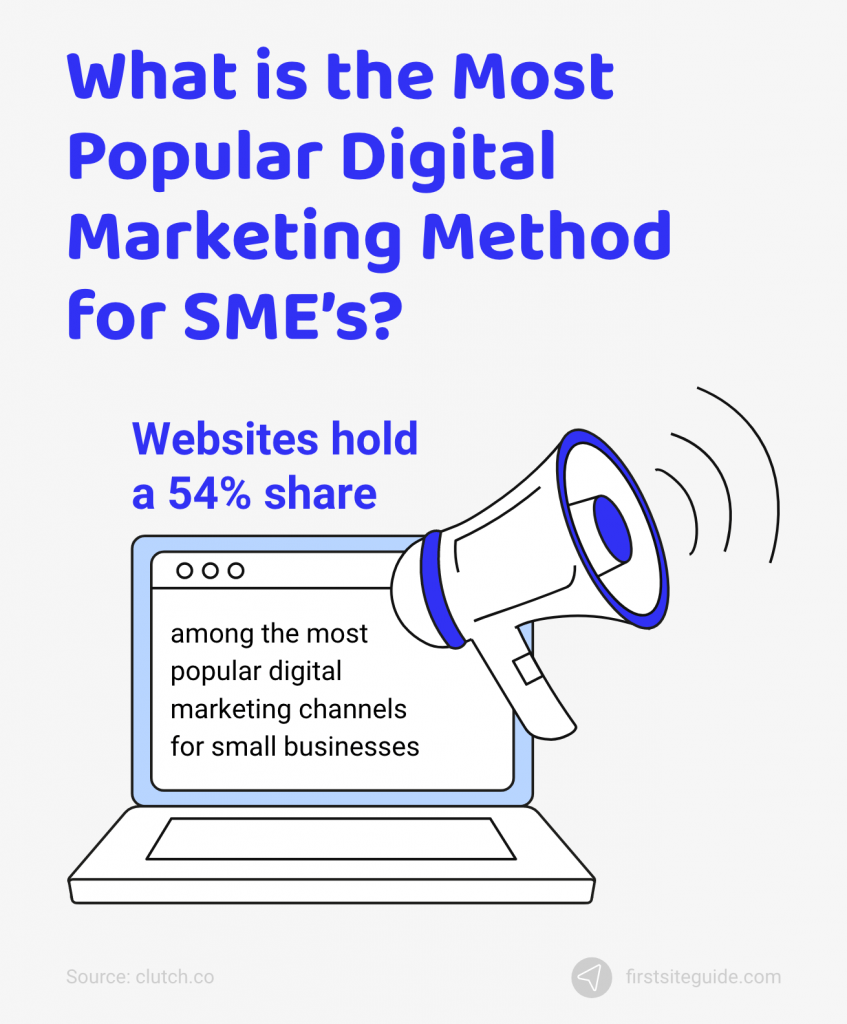
Source: Clutch.co
31. 72% of small businesses focus on increasing revenue.
The primary point of any business is to make money, and the primary focus of small businesses is increasing revenue, with about 72%. Furthermore, about 60% of small businesses consider establishing new customer relationships very important, with marketing and advertising coming in as the third most important thing at only 46%.
Source: Businessinsider.com
The biggest challenges for small businesses
Starting a small business comes with its fair share of challenges. Maintaining a small business can be even more challenging. The struggles of running a small business are very real, but the profits can be worthwhile if you can overcome the challenges.
Let’s look at the biggest challenges that small businesses face, expressed in numbers and statistics.
32. 31% of small businesses shut down in the last three months.
The COVID-19 pandemic has been a disaster for small businesses. Almost a third of small and medium-sized businesses have shut down in the last three months, and the situation doesn’t seem to be getting any better. Out of the 31% of all small businesses that shut down, many closures have been due to regulations and restrictions.
Source: Dataforgood.fb.com
33. 52% of small business owners say it’s hard to find qualified individuals.
Finding qualified individuals to work for your business has always been challenging, but the problem has grown substantially in recent years. About 52% of small business owners claim that it’s far more difficult to find people with appropriate credentials and qualifications to work at their business.
Source: Surveymonkey.com
34. 83% of small business owners say employee retention is their top objective.
Once you do manage to find qualified employees for your business, it’s essential to retain them. About 83% of all employers say that employee retention is one of their top objectives, as it maintains a stable workforce.
Source: Visualcapitalist.com
35. 37% of small businesses offer higher salaries.
Over a third of small to medium-sized businesses tend to maintain employees by offering competitive salaries.
Source: Indeed.com
36. 70% of new employer firms survive at least two years.
It’s a well-known fact that not every small business makes it in the long run. Seven out of ten new employer-based small businesses survive a minimum of two years. Half of them last at least five years, about a third will pass the ten-year mark, and only a quarter of them will last over 15 years.
Source: Smallbusiness.yahoo.com
37. The most common negative reason to close a small business is non-profitable operation.
There are more than a few reasons why people quit their small businesses. The primary positive reason is getting the opportunity to take a job or business opportunity.
Just like anything, there are way more negatives than positives. Some of the most common negative reasons to quit a small business are non-profitable operations, family and personal reasons, and taxes or bureaucracy.
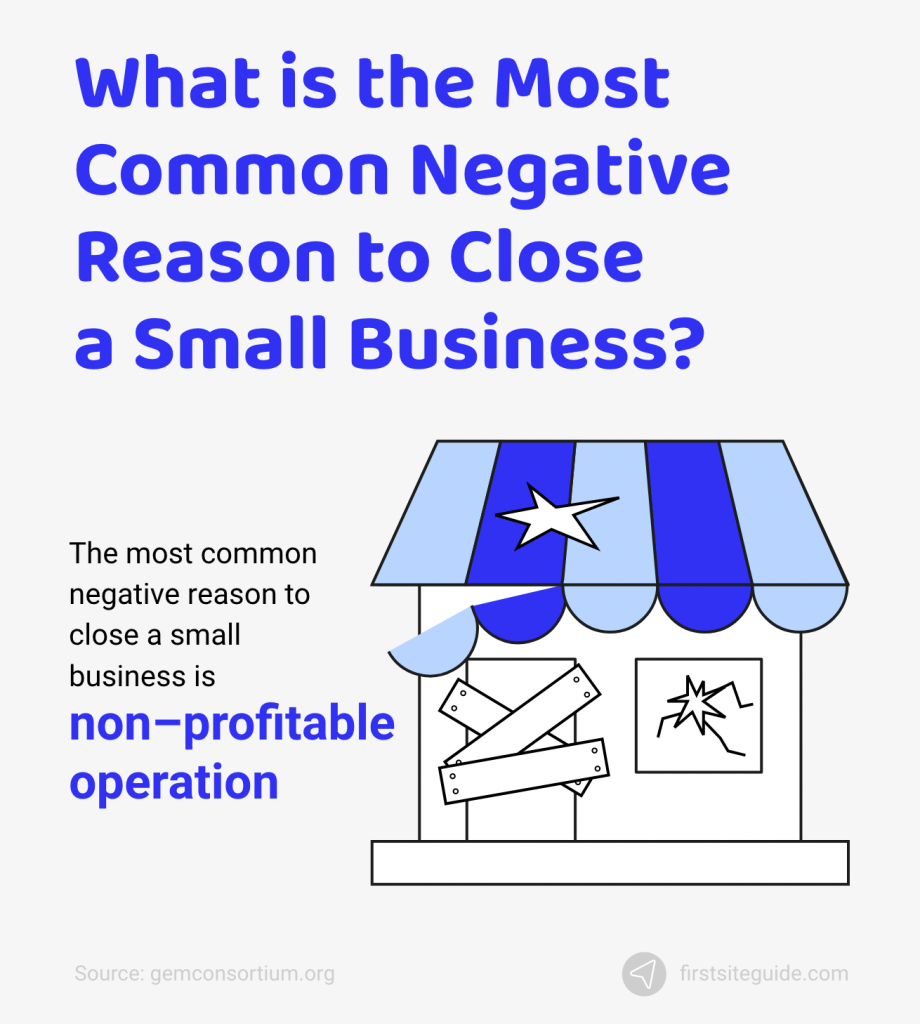
Source: Gemconsortium.org
38. 82% of business failures are due to cash flow issues.
A significant number of businesses that failed, about 82%, have noted that cash flow was one of the main reasons which caused the closure.
Source: Entrepreneur.com
39. 42% of startups fail because of no market need.
Startups can either be a flash in the pan, a successful business, or a life-support-like situation. Most startups (about 42%) fail because there is no market need for their firm. The runner-up reason, about 29%, is a lack of funds available to continue operations.
Source: Cbinsights.com
40. The average U.S. citizen works 1779 hours a year.
Small businesses are known for an ironclad work ethic that is required to help them break out of the small business label, and that’s why most owners and employees work a lot. The U.S. is the eleventh most hard-working country, clocking in about 1779 hours a year.
Source: Stats.oecd.org
41. 92% of small business owners don’t regret starting their business.
There’s something liberating about starting your very own business, and a significant amount of small business owners agree. About 92% of small business owners surveyed report that they don’t regret starting their small business.
Source: Fundera.com
42. The Small Business Optimism Index in the U.S. is up by 0.8 from 2020 to 2021.
While times might be tough, small business owners seem to be optimistic about the future. In a recent study from February 2021, the U.S. Small Business Optimism Index amounted to 95.8, which is a positive increase from a value of 95 in January 2021.
Source: Statista.com
Conclusion
Saying that small businesses are globally important would be an understatement, and the statistics written above really highlight this fact. While small businesses might currently be facing a hard time due to the coronavirus pandemic, it’s also one of the driving forces behind innovation.
Once the pandemic ends, we’re likely to experience a boom in small businesses, which will be fantastic for the global economy and the entrepreneurs driving it.

